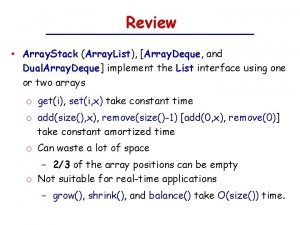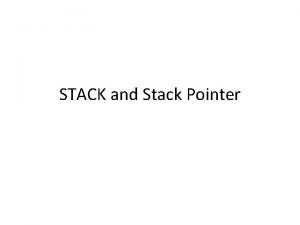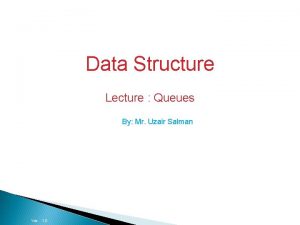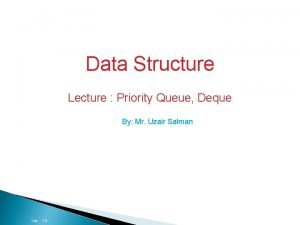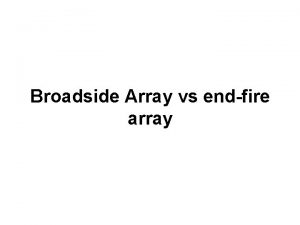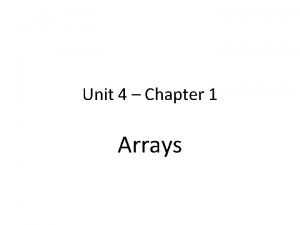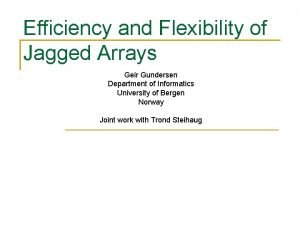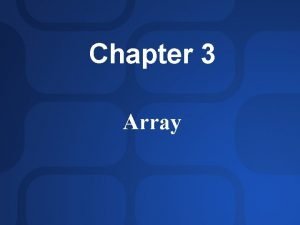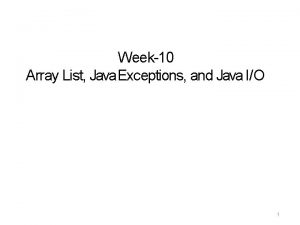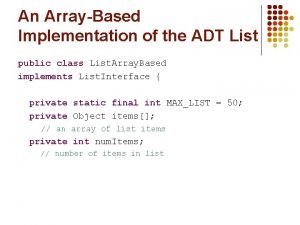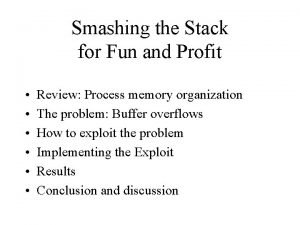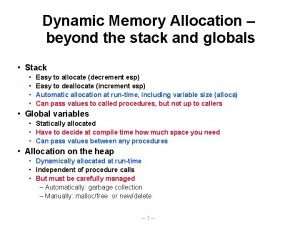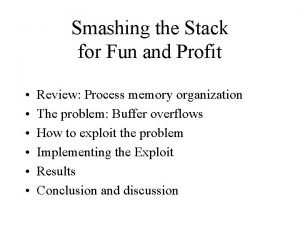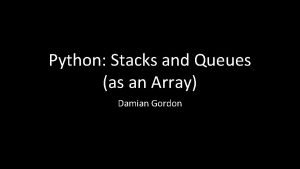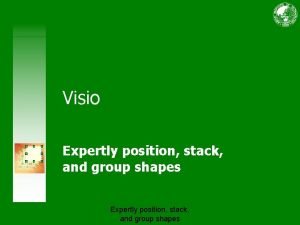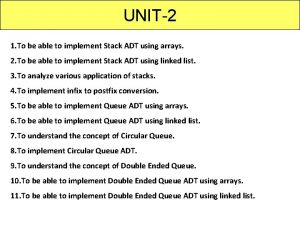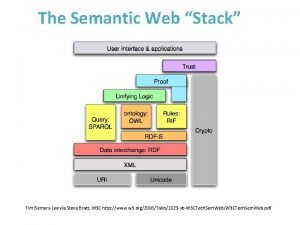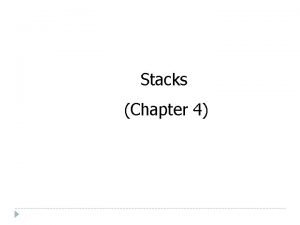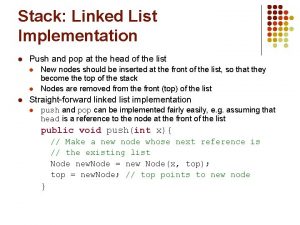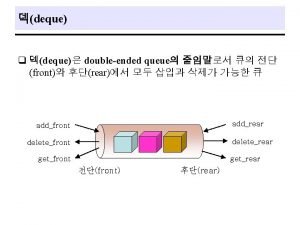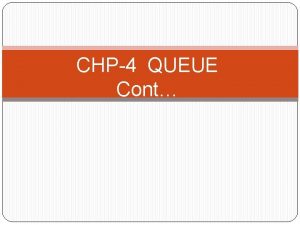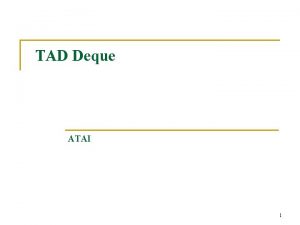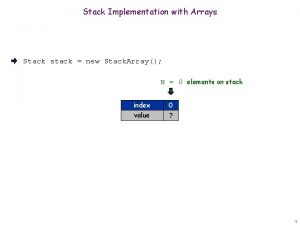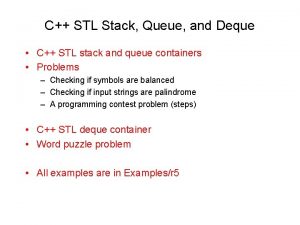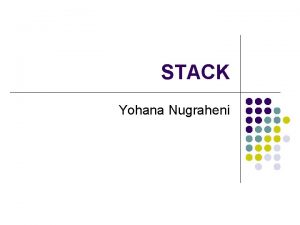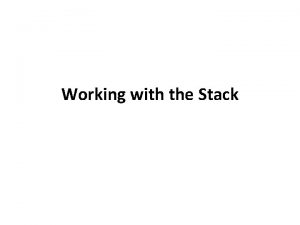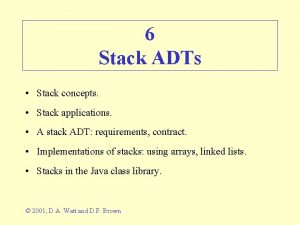Review Array Stack Array List Array Deque and
![Review • Array. Stack (Array. List), [Array. Deque, and Dual. Array. Deque] implement the Review • Array. Stack (Array. List), [Array. Deque, and Dual. Array. Deque] implement the](https://slidetodoc.com/presentation_image_h/eba42b16c12ae18b10295e364bcd48f8/image-1.jpg)































































- Slides: 64
![Review Array Stack Array List Array Deque and Dual Array Deque implement the Review • Array. Stack (Array. List), [Array. Deque, and Dual. Array. Deque] implement the](https://slidetodoc.com/presentation_image_h/eba42b16c12ae18b10295e364bcd48f8/image-1.jpg)
Review • Array. Stack (Array. List), [Array. Deque, and Dual. Array. Deque] implement the List interface using one or two arrays o get(i), set(i, x) take constant time o add(size(), x), remove(size()-1) [add(0, x), remove(0)] take constant amortized time o Can waste a lot of space − 2/3 of the array positions can be empty o Not suitable for real-time applications − grow(), shrink(), and balance() take O(size()) time.

Coming up • Rootish. Array. Stack: A list implementation with − get(i) and set(i, x) in constant time − add(i, x) and remove(i) in O(1 + size()-i) time − no more than O(size()1/2) wasted space − Suitable for real-time applications o in some languages (not Java) • Dual. Rootish. Array. Deque − A 2 -ended version

Rootish. Array. Stack • Store the stack as a List of blocks (arrays) − block k has size (k+1), for k=0, 1, 2, . . . , r − at most 2 blocks not full blocks 0 1 2 3 4 a b c d e f g h i k l j public class Rootish. Array. Stack<T> extends Abstract. List<T> { List<T[]> blocks; int n; . . . }

Space analysis • How much space is wasted? − r blocks have room for r(r+1)/2 elements r − To store n elements we need − r(r+1)/2 ≥ n − r ≥ (2 n)1/2 blocks are sufficient r+1 − We only waste O(n 1/2) space keeping track of the blocks • The size of the last 2 blocks is at most 2 r + 3 − Only waste O(n 1/2) space on non-full blocks − Wasted space is only O(n 1/2)

Rootish. Array. Stack – add(i, x) • As usual: − grow() if necessary − shift elements i, . . . , size()-1 right by one position public void add(int i, T x) { int r = blocks. size(); if (r*(r+1)/2 < n + 1) grow(); n++; for (int j = n-1; j > i; j--) set(j, get(j-1)); set(i, x); }

Rootish. Array. Stack – remove(i) • Also as usual: − shift elements i+1, . . . , size()-1 left by one position − shrink() if necessary public T remove(int i) { T x = get(i); for (int j = i; j < n-1; j++) set(j, get(j+1)); n--; shrink(); return x; }

Rootish. Array. Stack – grow() • Add another block of size r − runs in constant time in languages not requiring array initialization − otherwise, takes O(r) = O(size()1/2) time. protected void grow() { blocks. add(f. new. Array(blocks. size()+1)); }

Rootish. Array. Stack – shrink() • Remove blocks until there at most 2 partially empty blocks protected void shrink() { int r = blocks. size(); while (r > 0 && (r-2)*(r-1)/2 >= n) { blocks. remove(blocks. size()-1); r--; } }

Rootish. Array. Stack get(i) and set(i, x) • Find the block index b that contains element i (function i 2 b(i) ) • access element i - b(b+1)/2 within that block public T get(int i) { int b = i 2 b (i); int j = i - b*(b+1)/2; return blocks. get(b)[j]; } public T set(int i, T x) { int b = i 2 b(i); int j = i - b*(b+1)/2; T y = blocks. get(b)[j]; blocks. get(b)[j] = x; return y; }

Rootish. Array. Stack - i 2 b(i) • Converting the List index i into a block number b − 0, . . . , i consists of i+1 elements − Blocks 0, . . . , b can store (b+1)(b+2)/2 elements − We want to find minimum integer b such that o (b+1)(b+2)/2 ≥ i + 1 − Solve (b+1)(b+2)/2 = i + 1 using the quadratic equation − quadratic equation gives a non-integer solution b’ o actually two solutions, but only one is positive − set b = Γb’˥

Rootish. Array. Stack - summary • Theorem: A Rootish. Array. Stack − can perform get(i) and set(i, x) in constant time − can perform add(i, x) and remove(i) in O(1+size()-i) time − uses only O(size()1/2) memory in addition to what is required to store its elements • Key points: − Real-time • no amortization − Low-memory overhead • O(n 1/2) versus O(n) for other array-based stacks

Optimality of Rootish. Array. Stack • Theorem: Any data structure that allows insertions will, at some point during a sequence of n insertions be wasting at least n 1/2 space. • Proof: If the data structure uses more than n 1/2 blocks − Real-time − n 1/2 pointers (references) are being wasted just keeping track of blocks − Otherwise, the data structure uses k ≤ n 1/2 blocks • some block B has size at least n/k ≥ n 1/2 • when B was allocated, it was empty and therefore was a waste of n 1/2 space

Practical Considerations • The use of many arrays to store data means that we can't do shifting with 1 call to System. arraycopy() – Slower than other implementations when i is small • The solution to the quadratic formula in i 2 b(i) requires the square root operation − This can be slow − This can lead to rounding errors • can be corrected by checking that • (b+1)/2 < i ≤ (b+1)(b+2)/2 − Lookup tables can speed things • we only want an integer square root

Dual. Rootish. Array. Deque • Using a Rootish. Array. Stack for the internal stacks within a Dual. Array. Deque we obtain: − Theorem: A Dual. Rootish. Array. Deque • can perform get(i), set(i, x) in constant time • can perform add(i, x) remove(i) in O(1 + min{i, size()-i}) amortized time − uses only O(size()1/2) memory in addition to what is required to store its elements • A real-time version is possible, see − Brodnik, Carlsson, Demaine, Munro, and Sedgewick. Resizeable arrays in optimal time and space. Proceedings of WADS 1999

Review • Array-based implementations of Lists, Queues, Stacks, and Deques have many advantages − Constant-time access by position [get(i), set(i, x)] − Constant-amortized time addition and removal at the ends − Space-efficient versions use only O(n 1/2) extra space • Big disadvantage − Additions and removals in the interior are slow • Running time is at least Ω(min{i, size()-i})

Coming up… • Lists and queues based on (singly and doubly) linked lists – It might use an array of length 2 n to store n elements of data – get(i), set(i, x) are slow add(), remove() with an iterator take constant time • Space-efficient linked lists

Coming up… • Singly-linked lists – Efficient stacks and queues • Doubly-linked lists – Efficient deques • Space-efficient doubly-linked lists – Time/space tradeoff

Singly-linked lists • A list is a sequence of Node: • Node contains – a data value x – a pointer next to the next node in the list protected class Node { T x; Node next; } a b c d e null

Singly-linked lists (cont'd) • We keep track of the first node in the list (head) • We might also keep track of the last node (tail) public class SLList<T> extends Abstract. Queue<T> { Node head; Node tail; int n; . . . } tail head a b . . . y z null

Queues as singly-linked lists • A singly-linked list can implement a queue − enqueue at the tail − dequeue at the head • Requires special care to manage head and tail correctly − when adding to empty queue − when removing last element from queue tail head a front of the line b . . . y z back of the line null

Dequeuing (removing) an element tail head a b . . . tail e head null y z null public T poll() { T x = head. x; head = head. next; if (--n == 0) tail = null; return x; }

public boolean offer(T x) { Node u = new Node(); u. x = x; if (n == 0) { head = u; tail = u; } else { tail. next = u; tail = u; } n++; return true; } Enqueuing x tail null head tail head x a b null

Delicateness • This code is wrong − can you see why? public boolean offer(T x) { Node u = new Node(); u. x = x; if (n == 0) { head = u; tail = u; } else { tail = u; tail. next = u; } n++; return true; }

Stacks as singly-linked lists • A singly-linked list can also be used as a stack − push and pop are done by manipulating head tail head a top of the stack b . . . y z null bottom of the stack

Stack - push tail a b head e tail head null c d e null public T push(T x) { Node u = new Node(); u. x = x; u. next = head; head = u; if (n == 0) tail = u; n++; return x; }

Arbitrary insertion and deletions • In a singly-linked list, we can even do arbitrary insertions/deletions − if we are given a pointer to the preceding element • Getting a pointer to the ith node takes O(i+1) time protected Node get. Node(int i) { Node u = head; for (int j = 0; j < i; j++) u = u. next; return u; } head a b . . . u tail y z null

Deleting a node • Does not work for first node − no preceding node u! u d e protected void delete. Next(Node u) { if (u. next == tail) tail = u; u. next = u. next; }

Adding a node • Does not work for first node − no preceding node u! v u e protected void add. After(Node u, Node v) { v. next = u. next; u. next = v; if (u == tail) tail = v; }

In-Class Exercise • Write code for – add(i, x) – remove(i) • Code should run in O(1+i) time 29

Singly-linked list summary • Singly-linked lists support: − push(x), pop(), enqueue(x), dequeue() in constant time (in the worst case) − add(i, x), remove(i) in O(1+i) time • One Node is created per list item − Memory allocation overhead − Node contains data + 1 pointer/reference (next) − At least n pointers for a list of size n

Doubly-linked lists • Singly-linked lists fall just short of being able to implement a deque − No way to remove elements from the tail head a b . . . y can't access this node except through head z null

Doubly-linked lists • Doubly-linked lists maintain two pointers (references) per node − next - points to next node in the list − prev - points to previous node in the list protected class Node { Node next, prev; T x; } head null a b . . . y tail z null

Removing a node (incorrect) • This code is incorrect – Why? u p. prev d p e p. next protected void remove(Node p) { p. prev. next = p. next; p. next. prev = p. prev; n--; }

Removing a node (incorrect) • Doesn't correctly handle boundary cases head − p == head (so p. prev == null) − p == tail (so p. prev == tail) − p == head and p == tail head (sp p. prev == p. tail == null) protected void remove(Node p) { p. prev. next = p. next; p. next. prev = p. prev; n--; } d e u d d tail

protected void remove(Node p) { if (p == head && p == tail) { head = null; tail = null; } else if (p == head) { head = p. next; p. next. prev = null; } else if (p == tail) { tail = p. prev; p. prev. next = null; } else { p. prev. next = p. next; p. next. prev = p. prev; } n--; } Versus protected void remove(Node p) { p. prev. next = p. next; p. next. prev = p. prev; n--; }

Code is error prone • Code for boundary cases is troublesome − hard to write correctly − lots of cases − slow to execute (on some architectures) • We would like to get rid of boundary cases − need to get rid of head and tail protected void remove(Node p) { p. prev. next = p. next; p. next. prev = p. prev; n--; }

The dummy node technique • Replace head and tail with a dummy Node − dummy. next replaces head − dummy. prev replaces tail − dummy is always present; even in an empty list a b . . . y z dummy public class DLList<T> extends Abstract. Sequential. List<T> { protected Node dummy; protected int n; . . . }

Creating a new (empty) list public DLList() { dummy = new Node(); dummy. next = dummy; dummy. prev = dummy; n = 0; } dummy

Removing a node • Now removing a node is easy u p. prev d p e p. next protected void remove(Node p) { p. prev. next = p. next; p. next. prev = p. prev; n--; }

Removing a node • The same code works even when removing the last node p protected void remove(Node p) { p. prev. next = p. next; p. next. prev = p. prev; n--; } p. prev == p. next == dummy p dummy

Adding a node • Add the new Node u just before Node p protected Node add(Node u, Node p) { u. next = p; u. prev = p. prev; u. next. prev = u; u. prev. next = u; n++; return u; } u u d p. prev p p

Exercise • This code is not correct. Why? protected Node add(Node u, Node p) { u. next = p; u. next. prev = u; u. prev = p. prev; u. prev. next = u; n++; return u; } u u d p. prev p p

Finding a node • To find the ith node search − from the front if i < size()/2 − from the back otherwise • O(1+min{i, size()-i}) time • Fast − when i~0 (head) − when i~size() (tail) protected Node get. Node(int i) { Node p = null; if (i < n/2) { p = dummy. next; for (int j = 0; j < i; j++) p = p. next; } else { p = dummy; for (int j = n; j > i; j--) p = p. prev; } return(p); }

Removing and Adding • add(i, x) and remove(i) are now easy − Find the appropriate node p − Add x before p (or remove p) • Takes O(1 + min{i, size()-i}) time public void add(int i, T x) { add(get. Node(i), x); } public T remove(int i) { Node p = get. Node(i); remove(p); return p. x; }

Getting and setting • get(i) and set(i, x) are easy too − and take O(1 + min{i, size()-i}) time public T get(int i) { return get. Node(i). x; } public T set(int i, T x) { Node u = get. Node(i); T y = u. x; u. x = x; return y; }

Doubly-linked lists - summary • Doubly-linked lists support − add(i, x), remove(i) in O(1 + min{i, size()-i}) time • deque operations run in constant time per operation − get(i), set(i, x) in O(1+min{i, size()-i}) time − insertion/removal of any node in constant time • given a reference to the node being deleted or • a reference to the node after the insertion

Memory-efficient linked lists • Linked lists are great, except − Each value is stored in its own list node • Each insertion requires allocating a new node • Each node stores 2 pointers − Wasted space is at least 2 × size() × sizeof(pointer) • If data values are small (e. g. , Integer) then wasted space can exceed the space for data

Memory-efficient linked lists • Idea: − group list elements into blocks (arrays) − blocks have size b+1 − each block stores b-1, b, or b+1 values • except the last block, which can be more empty − store the blocks in a linked list a b c d e b=3 f g h i j last block - partly full

Space analysis • The number of blocks is at most − 1 + size()/(b-1) − each block wastes a constant [O(1)] amount of space − wasted space is O(b+n/(b-1)) − By making b larger we can reduce the wasted space • limit is b ~ n 1/2 a b c d e f g h i j

Block data structure • We represent each block as a Bounded. Array. Deque − Array. Deque with size of backing array a set fixed − a. length = b+1 − no grow() or shrink() operations • Sometimes we will want to − move the last element in node u to the front u. next − move the first element in block i to the back of block i-1 − These operations take constant time in a Bounded. Array. Deque

Finding an element • To find the ith element we public T get(int i) { if (i < n/2) { find the block that Node u = first; contains it − Takes time O(1 + (min{i, size()-i} / b)) − faster than a standard linked list a b c d e b=0 b=3 f g int b = 0; while (b + u. x. size() < i + 1) { b += u. x. size(); u = u. next; } return u. x. get(i-b); } else {. . . h b=7 i j b=9

Insertion - easy case O(b) time • To insert into block j – check if any of blocks j, j+1, j+2, . . . , j+b-1 are not full • if yes, then there is space, so do shifting to make room • requires at most 2 b deque operations • requires shifting at most b elements in one of the deques ( O(b) time ) Insert x here a b c d e f a x b c d e g h i j k f h i j g k

Insertion – full case O(b 2) time • If blocks j, j+1, . . . j+b-1 are all full – these b blocks contain a total of b(b+1) elements – repartition them into b+1 blocks each containing b elements – then insert into the (now not full) block Insert x here a b c d O(b 2) time e f g h i j k l a b c d e f g h i j k l a x b c d e f g h i j k l

Removal- easy case O(b) time • To remove an element from block j – if any of blocks j, j+1, j+2, . . . contain more than b-1 elements • do shifting so that block j contains at least b elements • remove element from block j delete this a b c d e f g a c d e f g g

Removal– hard case O(b 2) time • If blocks j, . . . , j+b-1 each contain b-1 elements – we have b blocks each containing b-1 elements – redistribute so that we have b-1 blocks each containing b elements – delete the element O(b 2) time delete this a b c d e f a c d e f f

Space-Efficient Linked List (SElist) • A Compact. DLList has the following properties – wasted space is O(size()/b) – get(i) and set(i, x) each take • O(1 + min{i, size()-i}/b) time – remove(i) and add(i, x) take time • O(b + min{i, size()-i}/b) usually • O(b 2 + min{i, size()-i}/b) occasionally • What do we mean by usually and occasionally?

Amortized analysis of Compact. DLLists • We use a credit scheme – A block with b+1 elements or b-1 elements has 1 credit – A block with b elements has 0 credits • Main idea: – When insertion and removal take b 2 time, we will take away b spare credits – With every insertion and removal we create at most one new credit • Conclusion: At most one out of every b insertion/removals takes b 2 time

Weight-watchers analogy • A hamburger costs 8 credits – [analogous to: operation that takes O(b 2) time] • Every hour of workout gives you one credit – [analagous to: operation that takes O(b) time] • The maximum number of hamburgers you are allowed to eat is – (# hours spent working out)/8

Analysis of insertion (not full case) • At most one credit is created by insertion – (maybe none) insert x here ₡ a b c d ₡ e f ₡ a x b c g h i j ₡ d e k ₡ f g h i j k

Analysis of insertion (full case) • b credits are freed up and one credit is added insert x here ₡ a b c d ₡ e f ₡ g h i j k l 3 credits freed now a b c ₡ a x b c d e f g h i j k l 1 credit is added d e f g h

Analysis of removal (easy case) • At most one new credit is added delete this ₡ a b ₡ c d e f ₡ a b c ₡ a c d e ₡ f ₡ d e g g ₡ f g

Analysis of insertion (sparse case) • b credits are freed and one credit is added. delete this ₡ a b ₡ ₡ c d e f 3 credits freed a b c d e f ₡ a c 1 credit is added d e f

Analysis wrap up • In a sequence of n add/remove operations – At most n/b takes O(b 2) time – Others take O(b) time • Total time is – O(nb + (n/b)b 2) = O(nb) – O(b) amortized time per operation

Compact doubly-linked list (summary) • Theorem: A Compact. DLList is an implementation of the List interface with the following properties: – get(i) and set(i, x) each take • O(1 + min{i, size()-i}/b) time – remove(i) and add(i, x) take • O(b + min{i, size()-i}/b) amortized time – The amount of memory used beyond that needed to store the data is O(n/b) – The number of memory allocation/deallocations during a sequence of n add/remove operations is O(n/b)
 In a rootisharraystack, a call to get(20) will return
In a rootisharraystack, a call to get(20) will return Deque and priority queue
Deque and priority queue Definition of stack pointer
Definition of stack pointer Output restricted deque
Output restricted deque Deque salman
Deque salman Deque salman
Deque salman Deque falls
Deque falls Stack smashing vs stack overflow
Stack smashing vs stack overflow Dilakukan perintah top(push(b,s))
Dilakukan perintah top(push(b,s)) Program stack
Program stack North bridge south bridge
North bridge south bridge Difference between broadside and endfire array
Difference between broadside and endfire array Difference between an array and a linked list
Difference between an array and a linked list Array list and vector in java
Array list and vector in java Public class test collection 1
Public class test collection 1 Array advantages and disadvantages
Array advantages and disadvantages Diketahui suatu array segitiga memiliki 4 baris dan kolom
Diketahui suatu array segitiga memiliki 4 baris dan kolom Jagged array
Jagged array Associative array vs indexed array
Associative array vs indexed array Larik adalah
Larik adalah Keuntungan dari sparse array adalah:
Keuntungan dari sparse array adalah: Contoh array 1 dimensi dan 2 dimensi
Contoh array 1 dimensi dan 2 dimensi Photovoltaic array maximum power point tracking array
Photovoltaic array maximum power point tracking array Chapter review motion part a vocabulary review answer key
Chapter review motion part a vocabulary review answer key Ap gov review final exam review
Ap gov review final exam review Nader amin-salehi
Nader amin-salehi Traditional and systematic review venn diagram
Traditional and systematic review venn diagram Narrative review vs systematic review
Narrative review vs systematic review Java exceptions list
Java exceptions list Array based implementation of list adt
Array based implementation of list adt List the objectives of a formal technical review.
List the objectives of a formal technical review. What are the undefined terms in the axiom set
What are the undefined terms in the axiom set Singly vs doubly linked list
Singly vs doubly linked list List h shows account.
List h shows account. Perbedaan single linked list dan double linked list
Perbedaan single linked list dan double linked list Select list item list index too large
Select list item list index too large Smashing the stack for fun and profit
Smashing the stack for fun and profit Aleph one smashing the stack for fun and profit
Aleph one smashing the stack for fun and profit Push and pop in stack
Push and pop in stack Stack and heap memory
Stack and heap memory Reverse polish notation calculator
Reverse polish notation calculator Smash the stack for fun and profit
Smash the stack for fun and profit Python stack and queue
Python stack and queue Advantage and disadvantage of stack
Advantage and disadvantage of stack Difference between one pipe system and single stack system
Difference between one pipe system and single stack system Eurocircuits layer stack
Eurocircuits layer stack Visio how to flip a shape
Visio how to flip a shape Stack algorithm
Stack algorithm Two-stack pda examples
Two-stack pda examples Ssh protocol stack
Ssh protocol stack Semantic web
Semantic web Grc stack
Grc stack Node_latest_armhf.deb
Node_latest_armhf.deb What is stack card in warehouse
What is stack card in warehouse Operations of stack
Operations of stack Stack guard
Stack guard Stack smashing
Stack smashing Push(stack,l)
Push(stack,l) Netflix microservices stack
Netflix microservices stack Rtx 4100
Rtx 4100 Non executable stack buffer overflow
Non executable stack buffer overflow Ranap protocol stack
Ranap protocol stack Which organelle looks like a stack of puffy pancakes
Which organelle looks like a stack of puffy pancakes Network stack adalah
Network stack adalah Ns3 training
Ns3 training
